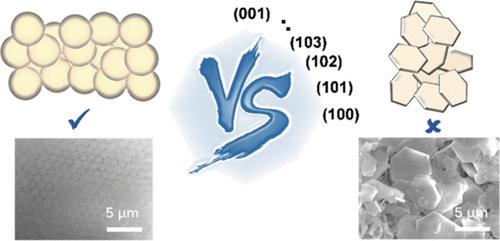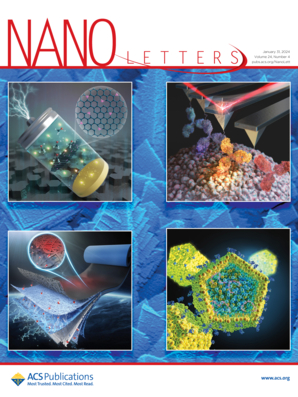生物矿化启发构建无枝晶锌阳极的致密球形堆栈
IF 9.6
1区 材料科学
Q1 CHEMISTRY, MULTIDISCIPLINARY
引用次数: 0
摘要
锌离子水电池(AZIBs)因其高度安全性和低成本而被认为是最有前途的储能系统之一。然而,锌阳极表面不受控制的锌树枝状形态沉积严重降低了 AZIB 的循环寿命。在此,受自然生物矿化的启发,通过在电解液中添加生物大分子实现了均匀的球形锌沉积。所提出的生物大分子通过调节金属锌高指数平面的相对生长速度,使 Zn2+ 形成致密的球形沉积,有效避免了不规则锌枝晶的破坏。添加了这种生物大分子的对称电池可在 1 mA cm-2 的条件下稳定循环 3200 小时。这项工作揭示了在单晶平面控制策略之外,如何将金属沉积的形态调节扩展到球形,以获得稳定的金属阳极。本文章由计算机程序翻译,如有差异,请以英文原文为准。

Biomineralization Inspired the Construction of Dense Spherical Stacks for Dendrite-Free Zinc Anodes
Aqueous zinc-ion batteries (AZIBs) are considered to be one of the most promising energy storage systems due to their high degree of safety and low cost. However, the deposition of the uncontrolled zinc dendritic morphology on the surface of the Zn anode seriously reduces the cycle life of AZIBs. Herein, inspired by natural biomineralization, a uniform spherical zinc deposition is achieved via the addition of a biological macromolecule to the electrolyte. The proposed biological macromolecule makes Zn2+ undergo dense spherical deposition by regulating the relative growth rate of high-index planes of metal zinc, effectively avoiding the destruction from irregular zinc dendrites. The symmetric cell with the addition of such a biological macromolecule can be stably cycled for >3200 h at 1 mA cm–2 for 1 mAh cm–2. This work sheds light on expanding morphological regulation of metal deposition to spherical shapes for stable metal anodes in addition to a single-crystal plane control strategy.
求助全文
通过发布文献求助,成功后即可免费获取论文全文。
去求助
来源期刊

Nano Letters
工程技术-材料科学:综合
CiteScore
16.80
自引率
2.80%
发文量
1182
审稿时长
1.4 months
期刊介绍:
Nano Letters serves as a dynamic platform for promptly disseminating original results in fundamental, applied, and emerging research across all facets of nanoscience and nanotechnology. A pivotal criterion for inclusion within Nano Letters is the convergence of at least two different areas or disciplines, ensuring a rich interdisciplinary scope. The journal is dedicated to fostering exploration in diverse areas, including:
- Experimental and theoretical findings on physical, chemical, and biological phenomena at the nanoscale
- Synthesis, characterization, and processing of organic, inorganic, polymer, and hybrid nanomaterials through physical, chemical, and biological methodologies
- Modeling and simulation of synthetic, assembly, and interaction processes
- Realization of integrated nanostructures and nano-engineered devices exhibiting advanced performance
- Applications of nanoscale materials in living and environmental systems
Nano Letters is committed to advancing and showcasing groundbreaking research that intersects various domains, fostering innovation and collaboration in the ever-evolving field of nanoscience and nanotechnology.
 求助内容:
求助内容: 应助结果提醒方式:
应助结果提醒方式:


